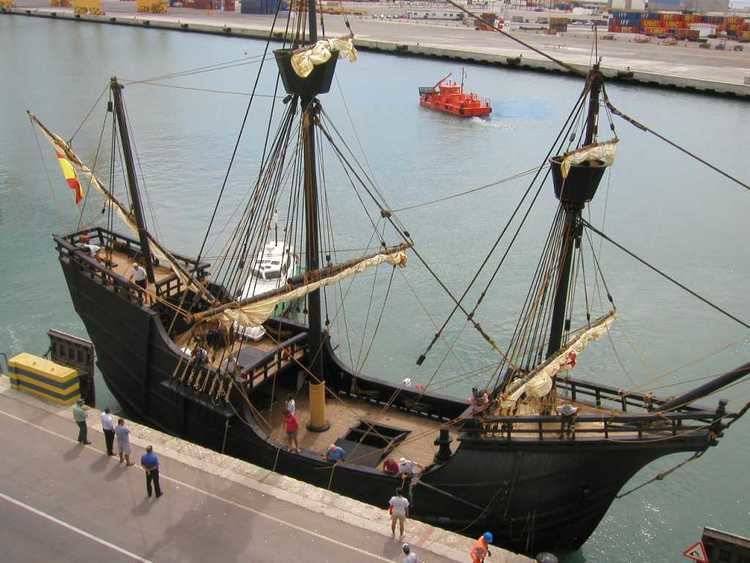Name Victoria Launched 1519 Beam 7.5 m | Ordered 1518 Length 28 m | |
 | ||
Namesake Santa Maria de la Victoria Notes First ship to circumnavigate the globe. | ||
Victoria (or Nao Victoria, as well as Vittoria) was a Spanish carrack and the first ship to successfully circumnavigate the world. Victoria was part of a Spanish expedition commanded by the Portuguese explorer Ferdinand Magellan, and after his death during the voyage, by Juan Sebastián Elcano. The expedition began on August 10, 1519 with five ships but Victoria was the only ship to complete the voyage, returning on September 6, 1522. Magellan was killed in the Philippines. The ship was built at a shipyard in Gipuzkoa, with the Basques being reputed shipbuilders at the time, and along with the four other ships, she was given to Magellan by King Charles I of Spain (The Holy Roman Emperor Charles V). Victoria was named after the church of Santa Maria de la Victoria de Triana, where Magellan took an oath of allegiance to Charles V. Victoria was an 85 ton ship with a crew of 42.
Contents
The four other ships were Trinidad (110 tons, crew 55), San Antonio (120 tons, crew 60), Concepcion (90 tons, crew 45), and Santiago (75 tons, crew 32). Trinidad, Magellan's flagship, Concepcion, and Santiago were wrecked or scuttled; San Antonio deserted the expedition during the navigation of the Straits of Magellan and returned to Europe on her own.
Victoria was rated a carrack or nao (ship), as were all the others except Santiago, which was a caravel.
Crew
The voyage started with a crew of about 265 men aboard five ships. Of all these, only 18 men returned alive on Victoria. Many of the men died of malnutrition. Beginning the voyage, Luis De Mendoza was her captain. On April 2, 1520, after establishing a settlement they called Puerto San Julian, in Patagonia a fierce mutiny involving three captains broke out, but it was ultimately quelled. Antonio Pigafetta's and other reports state that Luis de Mendoza and Gaspar Quesada, captain of Concepcion were executed and the remains hung on gallows on the shore. Juan de Cartagena, captain of San Antonio was marooned on the coast. Duarte Barbosa, a Portuguese who had sided with Magellan in facing the mutiny, then became the captain of Victoria. According to Pigafetta, after Magellan's death on April 27, 1521, at the Battle of Mactan, remnants of the fleet tried to retrieve Magellan's body without success. Thereafter, Duarte Barbosa and João Serrão were elected leaders of the expedition. On May 1, 1521 they were invited by rajah Humabon of Cebu, of the Philippines to a banquet ashore to receive a gift for the king of Spain. There most were killed or poisoned, including Duarte Barbosa and João Serrão, who was brought by natives who wanted to exchange him for weapons, but was left behind. Pilot João Carvalho, who had survived the trap, then became the captain of Victoria. In August, near Borneo he was deposed and Juan Sebastián Elcano became captain for the remainder of the expedition.
Returning crew
Out of an entire expedition of 260 people, only 18 returned to Seville with the expedition (many others deserted), which by the end was only made up of the crew of Victoria.
They were:
Out of all these survivors, Antonio Pigafetta was the most significant because his journals supply most of the information known about the first expedition around the world.
Voyage
The long circumnavigation began in Seville in 1519 and returned to Sanlúcar de Barrameda on September 6, 1522, after traveling 68,000 kilometres (42,000 mi), 35,000 kilometres (22,000 mi) of which was largely unknown to the crew. On December 21, 1521, Victoria sailed on from Tidore alone because the other ships left the convoy due to lack of food/water rations. The ship was in terrible shape, with her sails torn and only kept afloat by continuous pumping of water. Victoria managed to pull through and return to Spain with a shipload of costly spices, the value of which was greater than the cost of the entire original fleet.
Victoria was later repaired, bought by a merchant shipper and sailed for almost another fifty years before being lost with all hands on a trip from the Antilles to Seville in about 1570.
Replicas
A replica was built in 1992 and is operated by the Fundación Nao Victoria, Seville.
In 2006, to celebrate the Bicentennial of Chile, an entrepreneur from Punta Arenas founded a project to build a replica of the first ship to circumnavigate the globe and discover the Strait of Magellan, which was also one of the first European voyages to explore Chile’s extreme south. The search for the original plans of Nao Victoria took longer than expected and the project was delayed by almost three years, from 2006 to 2009. The replica was finally completed by 2011. Although it was not possible to complete the project in time for the celebration of the bicentennial in 2010, the project’s creator received a Presidential Medal from the President of Chile.
